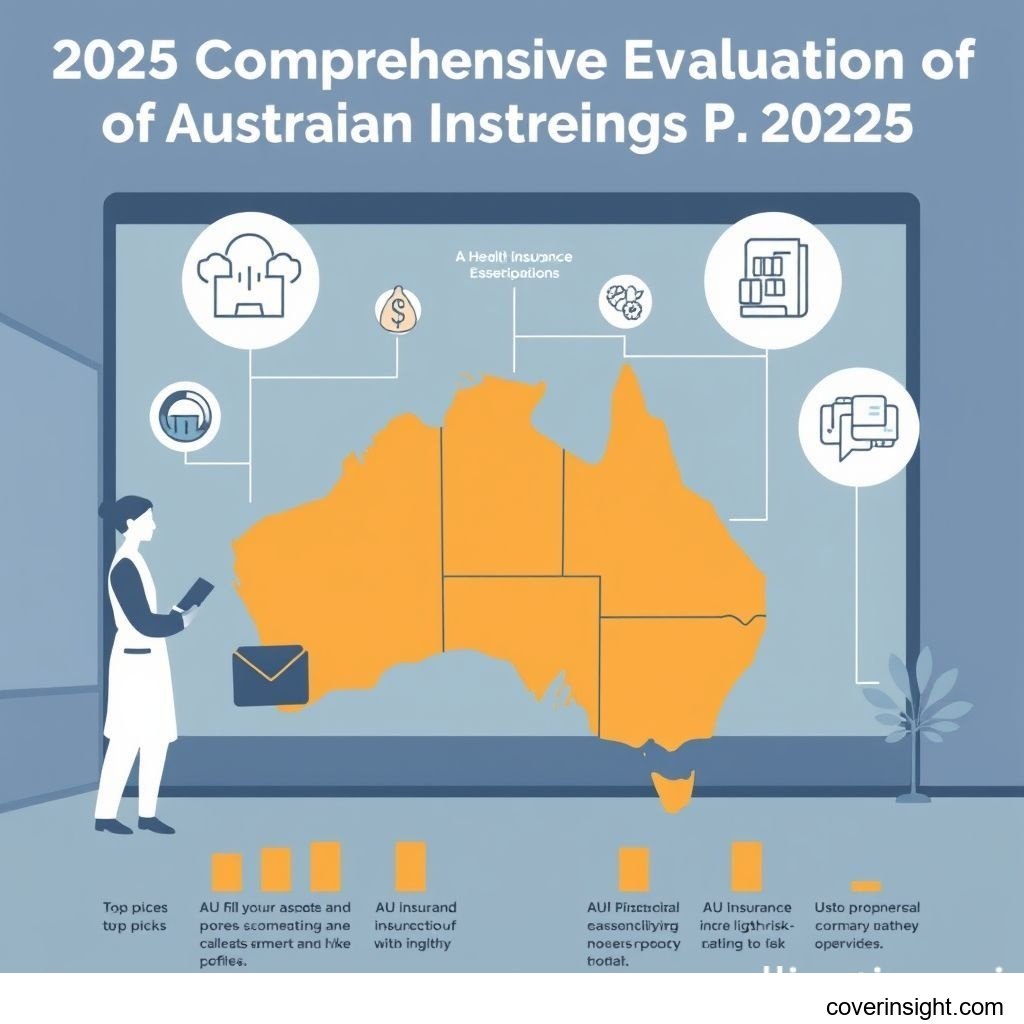Introduction
As Australia charges into 2025, the landscape of health insurance continues to evolve, making health insurance comparisons more crucial than ever for individuals and families. Navigating the myriad of policies, providers, and price points can be a daunting task. This comprehensive guide aims to simplify the process, offering insights into finding the best coverage tailored to your needs, understanding provider performance, and making informed decisions. Whether you're a first-time buyer or looking to switch, mastering health insurance comparisons is key to securing your well-being and financial peace of mind in the coming year.
Coverage Details
Understanding what's included and excluded in a health insurance policy is fundamental before making any commitments. Policies vary significantly, impacting what you can claim for and how much you'll pay out of pocket.
What’s Included
Australian health insurance typically divides into two main categories: Hospital Cover and Extras Cover.
-
Hospital Cover: This covers the costs of treatment when you're admitted to a private hospital. Depending on your tier (Basic, Bronze, Silver, Gold), it can include:
-
Accommodation in a private hospital room.
-
Operating theatre fees.
-
Doctor's fees (often with a gap payment).
-
Prostheses.
-
Access to a wider range of specialists and shorter waiting times for elective surgeries compared to the public system.
-
Specific treatments like joint replacements, cataracts, or heart surgery, depending on the cover level.
-
-
Extras Cover (Ancillary Cover): This covers services not typically included in Hospital Cover, designed to manage out-of-hospital medical expenses. Common inclusions are:
-
Dental (general and major).
-
Optical (glasses, contact lenses).
-
Physiotherapy, chiropractic, osteopathy.
-
Podiatry.
-
Psychology and other allied health services.
-
Acupuncture and remedial massage.
-
Prescription medications not covered by the Pharmaceutical Benefits Scheme (PBS).
-
When conducting health insurance comparisons, carefully review the specific inclusions for each policy tier to ensure it meets your anticipated health needs.
Common Exclusions
While policies offer extensive benefits, it’s equally important to be aware of what they typically don't cover or have specific limitations on:
-
Waiting Periods: All new policies or upgrades come with waiting periods before you can claim. These vary for different services:
-
2 months for most hospital treatments.
-
12 months for pre-existing conditions (hospital).
-
12 months for obstetrics (pregnancy).
-
2-12 months for various extras services like major dental or optical.
-
-
Restricted Services: Some lower-tier hospital policies might cover specific treatments only on a "restricted" basis, meaning the insurer pays a minimal benefit, leaving you with a significant out-of-pocket cost.
-
General Practitioner (GP) Visits: Standard GP consultations are usually covered by Medicare, not private health insurance.
-
Emergency Ambulance (Non-Urgent): While some policies include ambulance cover, it's often limited to emergency services or specific states. Non-urgent transport is usually excluded.
-
Cosmetic Surgery: Procedures purely for cosmetic purposes are typically not covered.
-
Specific Medications: Medications listed on the PBS are generally covered by Medicare, not private health insurance, though some extras policies may cover a portion of non-PBS listed scripts.
Always read the Product Disclosure Statement (PDS) to understand the full scope of coverage and any limitations or exclusions. This is a critical step in effective health insurance comparisons.
Cost Analysis
The cost of health insurance is a primary consideration for most Australians. Premiums can vary significantly based on a range of factors, and understanding these can help you find more affordable options.
Price Factors
Several elements influence the price of your health insurance premiums:
-
Type of Cover: Gold-tier hospital policies and comprehensive extras policies will naturally be more expensive than basic covers.
-
Age: The Australian government's Lifetime Health Cover (LHC) loading can increase premiums by 2% for every year you delay taking out hospital cover after turning 31, up to a maximum of 70%.
-
State or Territory: Premiums can differ slightly between states due to local healthcare costs and regulatory variations.
-
Excess and Co-payments: Choosing a higher excess (the amount you pay upfront for a hospital admission) can reduce your regular premiums. Some policies also have co-payments, a daily fee for hospital stays.
-
Family Composition: Single, couple, single-parent, or family policies each have different pricing structures.
-
Rebates and Loadings: The Australian Government Private Health Insurance Rebate can reduce your premiums based on your income. Conversely, the Medicare Levy Surcharge (MLS) applies to higher income earners without private hospital cover, incentivising its uptake.
-
Provider: Different insurers have different pricing strategies for similar levels of cover, making health insurance comparisons essential.
Saving Tips
Maximising value and reducing costs requires strategic planning:
-
Compare Policies Annually: Don't stick with the same policy out of habit. Insurers adjust their prices and offerings. Regular health insurance comparisons can reveal better deals. Many Australians save hundreds by switching providers.
-
Choose the Right Excess: If you're generally healthy and can afford a higher upfront payment in case of hospitalisation, opting for a higher excess will lower your monthly premiums.
-
Review Your Cover: Are you paying for services you don't use? If your family structure changes or your health needs evolve, adjust your policy accordingly. For instance, if you're past childbearing years, you might not need obstetrics cover.
-
Bundle Policies: Some insurers offer discounts if you bundle Hospital and Extras cover with them.
-
Pay Annually: Many insurers offer a small discount (e.g., 2-4%) if you pay your premium yearly instead of monthly.
-
Maximise the Government Rebate: Ensure your income details are up-to-date with your insurer to receive the correct rebate, reducing your out-of-pocket premium.
-
Consider Loyalty Programs: Some insurers offer benefits or discounts for long-term members.
Choosing the Right Provider for Health Insurance Comparisons
Selecting the ideal health insurance provider goes beyond just price. It involves understanding your specific needs and effectively comparing policy features, customer service, and the insurer's overall reputation. This process ensures you get value and appropriate coverage.
Key Considerations for Policy Selection
Before diving into extensive health insurance comparisons, identify what truly matters to you:
-
Your Health Needs: Are you planning a family, managing a chronic condition, or generally healthy? Your life stage and health status dictate the type of cover you need.
-
Budget: Determine how much you can comfortably afford each month without compromising other financial commitments.
-
Preferred Doctors/Hospitals: If you have specific medical professionals or hospitals you wish to use, check if they have agreements with the insurer you're considering.
-
Waiting Periods: Understand the waiting periods for services you anticipate needing soon.
-
Customer Service: Research the insurer's reputation for claims processing, responsiveness, and overall support. Online reviews and industry ratings can provide insights.
-
Fund Type: Consider whether you prefer a for-profit or not-for-profit health fund. Not-for-profit funds often reinvest profits into benefits or lower premiums for members.
The Art of Effective Policy Comparisons
Armed with your needs, you can now conduct thorough health insurance comparisons:
-
Utilise Comparison Websites: Reputable comparison sites allow you to input your details and filter policies across multiple insurers based on your requirements.
-
Direct Quotes: Get direct quotes from insurers you're interested in, as sometimes deals aren't listed on comparison sites.
-
Review the Product Disclosure Statement (PDS): This document contains all the fine print – exclusions, limits, waiting periods, and benefit levels. It's crucial for understanding the real value of a policy.
-
Understand Gaps: Ask about typical out-of-pocket expenses (gaps) for common procedures. Even with private cover, you might still pay a portion of doctor's fees if they charge above the Medicare Benefits Schedule (MBS).
-
Look for Value-Adds: Some insurers offer wellness programs, health management tools, or discounts on health-related products, which can add value beyond standard benefits.
By systematically evaluating these points, your health insurance comparisons will lead to a policy that truly serves your interests.
Understanding Health Insurance Company Ratings AU
When evaluating providers, understanding insurance company ratings AU provides valuable insights into their performance, financial stability, and customer satisfaction. These ratings are crucial for making an informed choice.
How Ratings Are Determined
Insurance company ratings AU are typically compiled by independent financial analysis firms, consumer watchdog organisations, and sometimes by industry bodies. Key metrics often include:
-
Financial Strength: A company's ability to meet its policy obligations, assessed by solvency ratios, capital adequacy, and overall financial health. The Australian Prudential Regulation Authority (APRA) oversees this aspect.
-
Customer Satisfaction: Derived from surveys, complaints data, and reviews focusing on aspects like claims processing, ease of contact, and overall service quality.
-
Value for Money: Evaluation of the cost of premiums versus the benefits offered, considering average out-of-pocket expenses for members.
-
Complaints Data: The number and nature of complaints lodged against an insurer, often publicly available via the Private Health Insurance Ombudsman.
-
Product Offering: The breadth and flexibility of policies, including innovative features and suitability for diverse needs.
Top-Rated Insurers 2025: A Snapshot of Insurance Company Ratings AU
While specific rankings can fluctuate, several providers consistently receive high insurance company ratings AU due to their comprehensive offerings, competitive pricing, and strong customer service. As of 2025, those often highlighted for excellent performance include:
-
Medibank: Known for its extensive network and digital tools.
-
Bupa: Offers a wide range of policies and strong international presence.
-
HCF: A not-for-profit fund often praised for member benefits and transparency.
-
nib: Focuses on digital innovation and user-friendly interfaces.
-
Australian Unity: A diverse provider with a long history in health insurance.
When reviewing insurance company ratings AU, always consider the methodology behind them and how they align with your personal priorities. A company might be top-rated overall but not the best fit for your specific needs, particularly if you have unique health requirements.
Navigating High-Risk Insurance Options
For individuals with specific medical conditions, lifestyle factors, or occupations, securing appropriate cover can present unique challenges. This is where understanding high-risk insurance options becomes paramount.
Defining High-Risk Needs
"High-risk" in the context of health insurance often refers to situations that might lead to a higher likelihood of claims. This could include:
-
Pre-existing Conditions: Any illness, injury, or symptom that existed before you took out your private health insurance or upgraded your cover. Standard waiting periods (usually 12 months for hospital cover) apply before claims related to these can be made.
-
Older Age: As people age, the risk of developing various health conditions increases, leading to higher premiums or more limited options in some insurance types (though not strictly for private health insurance due to community rating).
-
High-Risk Occupations or Hobbies: While less directly impactful on private health insurance (which is community rated in Australia, meaning everyone pays the same for the same policy regardless of individual risk factors like occupation), these can affect related covers like income protection or life insurance.
-
Specific Lifestyle Choices: While Australian private health insurance doesn't discriminate based on lifestyle (e.g., smoking status), these factors can influence overall health, leading to greater reliance on services.
For private health insurance in Australia, the concept of "high-risk" primarily revolves around managing pre-existing conditions through waiting periods rather than outright denial of cover or significantly higher premiums for individuals due to personal risk factors.
Finding Suitable High-Risk Insurance Options
Despite the term "high-risk," finding comprehensive high-risk insurance options for health in Australia is facilitated by the community rating system. This means insurers cannot refuse to cover you or charge you more based on your health status, age, or past claims. However, they can apply waiting periods:
-
Be Prepared for Waiting Periods: This is the primary mechanism insurers use to manage the "risk" of pre-existing conditions. If you have a known condition, understand that you'll likely need to serve a 12-month waiting period before you can claim for it under a hospital policy.
-
Comprehensive Hospital Cover: Even with pre-existing conditions, once waiting periods are served, a robust Gold or Silver Plus hospital policy will provide comprehensive coverage for a wide range of medical conditions and treatments.
-
Extras for Ongoing Management: If your "high-risk" profile involves ongoing therapies (e.g., physiotherapy for a chronic back issue, psychology for mental health support), ensure your extras cover is sufficient. Again, waiting periods apply.
-
Government Support: Remember Medicare remains your primary safety net. Private health insurance supplements, it doesn't replace it.
-
Seek Advice: If your situation is complex, consider speaking with an accredited financial advisor or a health insurance broker who specialises in complex cases. They can help you navigate the nuances of various high-risk insurance options and policies to find the best fit. Insurance Resources Global, can also offer broad guidance.
FAQs
Navigating the complexities of private health insurance often brings common questions to the forefront. Here, we address some of the most frequently asked queries about health insurance comparisons and general coverage in Australia.
How much does health insurance comparisons cost?
The cost of private health insurance varies widely, depending on the type of cover (hospital, extras, or combined), your age, the state you live in, the insurer, and any excess you choose. As of 2025, basic hospital cover for a single person might start from around $80-$100 per month, while comprehensive gold-tier combined policies for families could exceed $500 per month. The best way to determine your specific cost is by performing detailed health insurance comparisons online or through a broker.
What affects premiums?
Premiums are influenced by several factors:
-
Level of cover: Basic, Bronze, Silver, Gold tiers.
-
Excess and co-payments: Higher excess generally means lower premiums.
-
Age: Lifetime Health Cover loading applies if you don't get hospital cover by age 31.
-
Government rebates: Income-tested rebates reduce your out-of-pocket cost.
-
State of residence: Premiums can differ slightly across states.
-
Insurer's pricing strategy: Each company sets its own prices.
Is it mandatory?
No, private health insurance is not mandatory in Australia. Medicare provides a public healthcare system for all citizens and permanent residents. However, the Australian government encourages private cover through incentives like the Private Health Insurance Rebate and disincentives like the Medicare Levy Surcharge (MLS) for higher-income earners without appropriate hospital cover.
How to choose?
Choosing the right policy involves:
-
Assessing your needs: What services are important to you (e.g., dental, optical, specific hospital treatments)?
-
Setting a budget: How much can you afford monthly?
-
Conducting health insurance comparisons: Use comparison tools and review PDS documents.
-
Checking waiting periods: Ensure you understand when you can claim for specific services.
-
Evaluating insurer reputation: Look at customer service and claims processing reviews.
For more detailed guidance, consider visiting authoritative sites like the Australian Prudential Regulation Authority or Insurance Council of Australia. You might also find helpful information on AU Insurance Home.
Consequences of no coverage?
Without private health insurance, you will rely solely on the public healthcare system (Medicare). This means:
-
Potentially longer waiting times for elective surgeries.
-
No choice of doctor or private hospital for your treatment.
-
No cover for "extras" services like dental, optical, or physiotherapy (unless you pay out-of-pocket).
-
Higher income earners (above certain thresholds) may be subject to the Medicare Levy Surcharge (MLS).
Conclusion
In the dynamic Australian health insurance market of 2025, mastering health insurance comparisons is no longer just an option but a necessity. By thoroughly understanding coverage details, analysing costs, and diligently comparing providers based on your unique needs and reliable insurance company ratings AU, you empower yourself to make truly informed decisions. Whether you are proactively seeking high-risk insurance options or simply looking for comprehensive family cover, the journey starts with meticulous research and a clear understanding of what each policy offers. Prioritise value, service, and suitability to secure a health insurance policy that truly delivers peace of mind and supports your well-being for years to come.









Comments